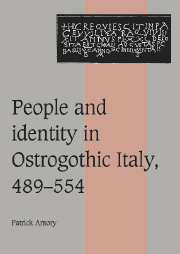Book contents
- Frontmatter
- Contents
- Preface
- List of rulers
- Terminology and vocabulary
- List of abbreviations
- Map of Ostrogothic Italy
- Introduction: Studying the barbarians in late antiquity
- 1 Ethnicity, ethnography and community in the fifth and sixth centuries
- 2 The Ravenna government and ethnographic ideology: from civilitas to bellicositas
- 3 Individual reactions to ideology I: names, language and profession
- 4 Complementary and competing ideals of community: Italy and the Roman Empire
- 5 Individual reactions to ideology II: soldiers, civilians and political allegiance
- 6 Catholic communities and Christian Empire
- 7 Individual reactions to ideology III: Catholics and Arians
- 8 The origin of the Goths and Balkan military culture
- Conclusion
- Appendix 1 The inquiry into Gundila's property: a translation and chronology
- Appendix 2 The Germanic culture construct
- Appendix 3 Archeological and toponymic research on Ostrogothic Italy
- Appendix 4 Dress, hairstyle and military customs
- Prosopographical Appendix: A prosopography of Goths in Italy, 489–554
- Bibliography
- Index
- Cambridge Studies in Medieval Life and Thought Fourth Series
8 - The origin of the Goths and Balkan military culture
Published online by Cambridge University Press: 03 December 2009
- Frontmatter
- Contents
- Preface
- List of rulers
- Terminology and vocabulary
- List of abbreviations
- Map of Ostrogothic Italy
- Introduction: Studying the barbarians in late antiquity
- 1 Ethnicity, ethnography and community in the fifth and sixth centuries
- 2 The Ravenna government and ethnographic ideology: from civilitas to bellicositas
- 3 Individual reactions to ideology I: names, language and profession
- 4 Complementary and competing ideals of community: Italy and the Roman Empire
- 5 Individual reactions to ideology II: soldiers, civilians and political allegiance
- 6 Catholic communities and Christian Empire
- 7 Individual reactions to ideology III: Catholics and Arians
- 8 The origin of the Goths and Balkan military culture
- Conclusion
- Appendix 1 The inquiry into Gundila's property: a translation and chronology
- Appendix 2 The Germanic culture construct
- Appendix 3 Archeological and toponymic research on Ostrogothic Italy
- Appendix 4 Dress, hairstyle and military customs
- Prosopographical Appendix: A prosopography of Goths in Italy, 489–554
- Bibliography
- Index
- Cambridge Studies in Medieval Life and Thought Fourth Series
Summary
If the term “Goth” in Italy was a claim or an ideological label for a disparate collection of changing individuals, who were the “Goths” who crossed the Isonzo to arrive in Italy in 489? Was there an original Balkan-based ethnic or cultural grouping characterized by the traits later considered “Gothic” under Theoderic and Justinian? What was this group, which may have had more internal cohesion than the various communities called Gothi in the subsequent decades of Italian history?
Although we know too little about the Theoderican Goths of the Balkans to judge them as we can the Goths of Italy, the grouping of 489 is not likely to have possessed a discrete ethnicity in the sense of consciousness of common descent. Like most of his Goths, Theoderic grew up in imperial provinces, and he seems to have recruited followers in Pannonia and Moesia just as he later did in Italy. The prosopography of Italian Goths shows diversity from the 490s onward. Theoderic's Gothic ideology would not emphasize descent until thirty years later, in the 520s.
What about culture? If many of the cultural traits associated with Gothi in ethnographic texts are drawn from the classicizing discourse of ethnography, such as ferocity or illiteracy, others were clearly present in Theoderic's followers upon their arrival in Italy. These include the occasional use of a Germanic language, of personal names of Germanic origin, occasional belief in the Arian heresy to which Theoderic subscribed, and the military profession.
- Type
- Chapter
- Information
- People and Identity in Ostrogothic Italy, 489–554 , pp. 277 - 313Publisher: Cambridge University PressPrint publication year: 1997



